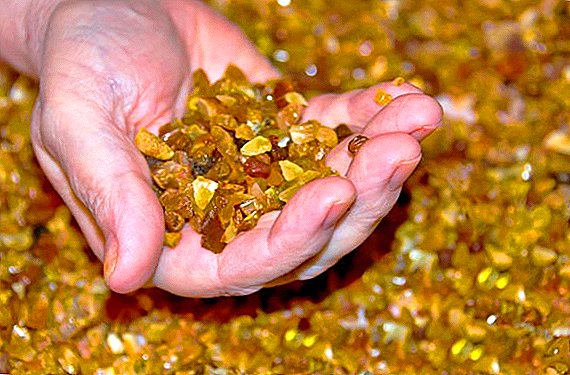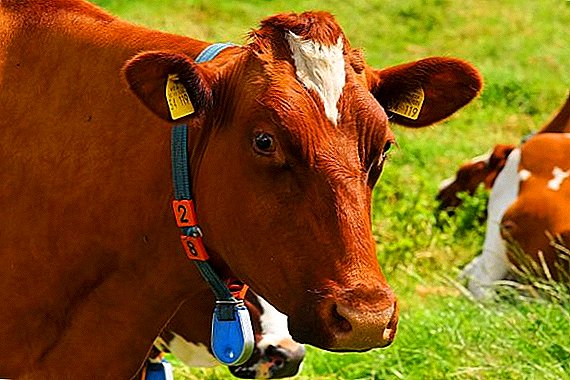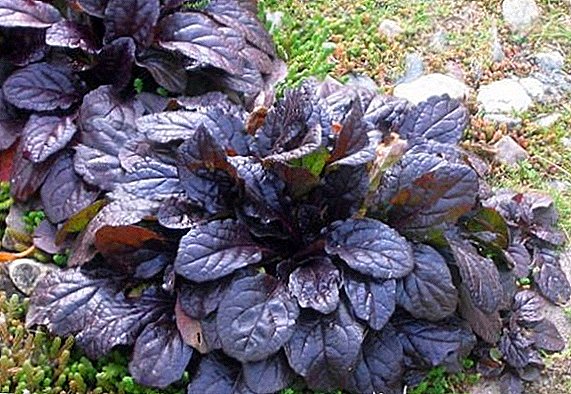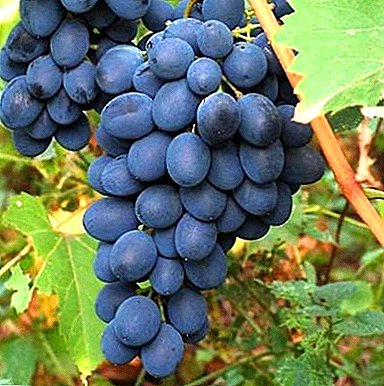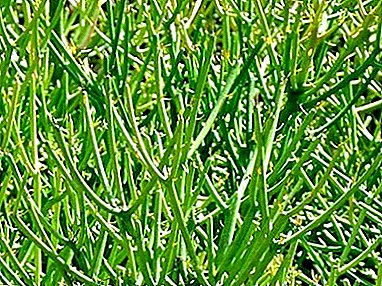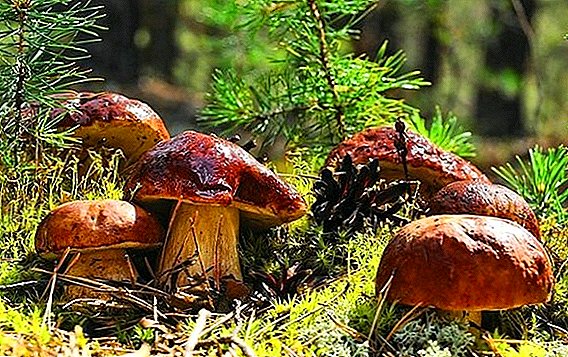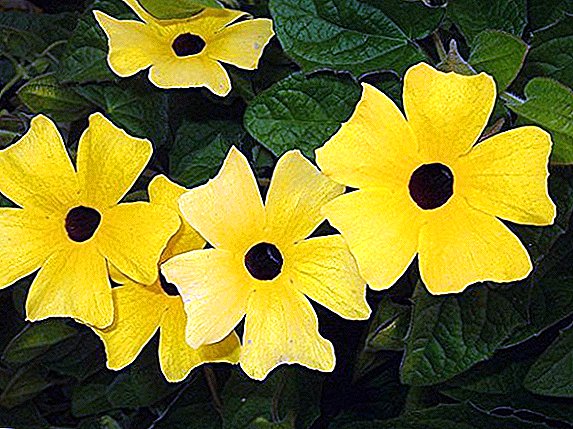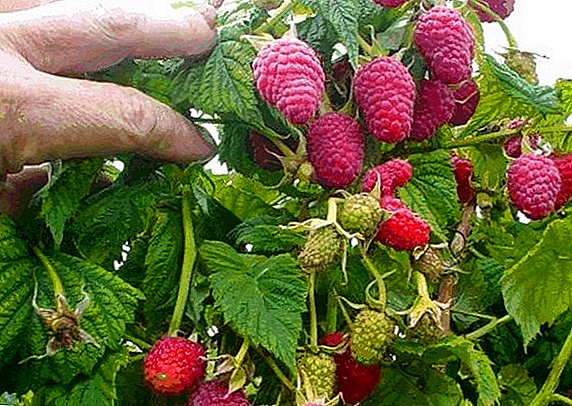 The zealous fans of large-fruited raspberry varieties have probably heard a lot of good reviews about “Maroseyka”. But lovers of sweet and fragrant berries certainly tried this variety more than once. What is the sort of raspberry "Maroseyka" in planting and care, what features stand out, and what experienced gardeners say about it - we will tell about all this later in the article.
The zealous fans of large-fruited raspberry varieties have probably heard a lot of good reviews about “Maroseyka”. But lovers of sweet and fragrant berries certainly tried this variety more than once. What is the sort of raspberry "Maroseyka" in planting and care, what features stand out, and what experienced gardeners say about it - we will tell about all this later in the article.
Inference history
The appearance of the variety "Maroseyka" in the 70s made among fans of garden and garden affairs a real sensation. It was a raspberry, which every land owner dreamed of.

It was characterized by high winter hardiness, endurance to typical diseases of berry crops, high content of sugar in fruits and large sizes of berries. Among all the abundance of domestic hybrids known at that time, “Maroseyka” was the first beshipnaya variety that simply amazed the imagination with its large fruit.
Did you know? People learned about the existence of raspberries approximately in the 3rd century BC. Oe., when the ancient Roman erudite writer Pliny the Elder on the island of Crete, stumbled upon wild thickets with prickly thorns and fragrant, palatable berries.
The authorship of a unique variety belongs to Viktor Kichin, a professor at the All-Russian Breeding-Technological Institute of Horticulture and Nursery. Working on the breeding "Maroseyki", he took as a basis for raspberry Scottish varieties with large-fruited and high taste characteristics. The breeder placed particular emphasis on the development of a hybrid genotype. Of the genes present, L1 was isolated, which was responsible for the size of the berries. 
The result was a high-quality high-quality variety. Its peculiarity also lies in the fact that for the entire period of its existence, the formation of mutants was not noticed. As Victor Kichina explains, the only drawback of the L1 gene is its instability. Over the years, in many hybrids it changes from a dominant to a recessive state.
As a result, the berries on varietal bushes grow shallower with each season, losing their original size. Such a result is very often obtained hybrids "Patricia", "Stolichnaya", "Mirage" belonging to the breeder. In contrast, the Maroseika variety practically does not produce mutated forms over the entire cycle of its life. Every year its fruits are distinguished by their large size, richness and sweetness in taste.
Did you know? The first raspberry berry in the possession of Kievan Rus was laid during the time of the Grand Duke of Kiev Vladimir Monomakh. The idea was realized by his sixth son, Yuri Dolgoruky.
Description and characteristics of the variety
The reverent attitude of the creator of the variety to his offspring is evident from the best qualities that were imparted to Maroseyka. In the reviews of her gardeners admire not only the size of the berries, but also their excellent taste. They say it is much closer to the true, forest. Let us consider in more detail the main features of the hybrid.
Learn how to grow raspberry varieties such as Vera, Bryansk Miracle, Monomakh's Cap, Giant of Moscow, Fortress, Fairy Tale, Himbo Top, Brilliant, Brusuvian, Lyachka, Zyugan, Shy, Indian Summer, Heritage.
Bushes
The plant stands out for its spreading and strong branching of the bushes. Each of them forms up to 5 replacement shoots and about a dozen sprouts of root shoots. The height of the plant varies in the range of 1-2 m. All branches are characterized by a bentless surface.
Spines replaces light felt patina. The shoots of the second year of life differ in strength and thickness. Fruit branches are elastic, have up to 5 orders of branching and give about 25 pieces of berry brushes. The leaves are large and corrugated, dark green. 
A plant without loss can withstand up to 15 degrees of frost, with long and severe cold requires additional shelter for the winter. It is distinguished by increased resistance to diseases typical for raspberries. From the fungi and bacteria, the stem protects the felt pubescence.
Did you know? Red raspberries are much healthier than yellow ones. According to experts, they lead among the entire fruit range of our latitudes in the amount of iron contained, and also contribute to skin rejuvenation, renewal of blood cells, and even help get rid of hangover.
Berries
In terms of ripening "Maroseyka" is considered an average grade. The period of fruiting in hybrid begins in the first decade of June. The berries are of large size, light crimson color and small number of small drupes. In shape, they resemble a blunt cone. Each weighs about 12 g, which is a pretty good indicator for berry crops.
Fruits are easily removed from the branches, and when fully matured they do not crumble. They taste sweet and tender. Possess strong aroma. Their grains are uniform, medium in size. Due to the elasticity of the pulp, raspberries are well transported.

Yield
Abundant fruiting varieties is one of its main achievements. On average, up to 4 kg of berries can be picked from one bush per season. And if you constantly feed and regularly moisten the plant, the yield increases to 6 kg. With the mass production of raspberry cultivation, the potential indicators of one weave fluctuate within 150 kg. But in order that the harvest does not exhaust the possibilities of culture, experts advise every decade to update the raspberries with young saplings.
Important! In order to control the root growth of the raspberry berry, experts advise to protect its perimeter with old slate sheets, roofing material and iron. The material must be buried in the ground, capturing a half-meter layer from the surface of the earth.
How to choose the seedlings
Further development and fruiting of the hybrid largely depends on the quality of the planting material. From a healthy seedling with strong strong roots, a viable shrub with good fruiting potential will be formed very quickly. And the sick and damaged by pests specimens will require a lot of time for resuscitation and, even with the elimination of the problem, will significantly lose by the quantity and quality of the crop.
Making the purchase of raspberry seedlings, Prefer specimens with a highly developed rhizome. Be sure to check out its freshness. To do this, evaluate the external state and simply scratch one of the root processes. On the quality of the material should appear fresh wood. But the presence of dry tips, dark spots or rotted areas indicates the wrong content of planting material, with the result that he was struck by infectious diseases, rot and mold.
In addition to the roots you need to inspect the aboveground part of the plant. It should have thick shoots with a uniform, solid surface, without any sagging and growths. You need to buy the sapling that completely meets all your requirements. The ideal option is the one that has at least 1-2 lignified sprout. This suggests a good survival rate of the culture and good wintering.
Did you know? As a result of scientific research, it was proved that women's lipstick with a raspberry fragrance causes a paradoxical feeling of power to tender, timid owners. But strong ladies, on the contrary, have an overwhelming desire to be protected.

Choosing a landing site
When looking for a comfortable plot for raspberry Special attention should be paid to several factors:
- physico-chemical characteristics and acidity of the soil;
- level of lighting area.
- The landing zone should be well lit throughout the day. For Marosekey, this is of particular importance, since in the shade the branches will stretch and will be very fragile. Under the weight of fruit brushes they will break.
- Raspberries should be located in an area where neighboring plants and economic structures will not cast shadow on raspberries. Otherwise, the fruit will be less fragrant and sour taste.
- In the selected place should not be collected rain and melt water, and there should be no prevailing winds and drafts.
- Avoid lowland places, as well as areas where groundwater is too close to the surface.
- The soil on the site must be enriched with nutrients, it also requires a layer of good drainage.
- Ideal for planting raspberries suitable areas with neutral acidity. If the land with an acidic environment prevails on your site, you will need to adjust them with lime fluff, dolomite flour or cement dust. On 1 square. m plot can be used from 150 to 300 g of the substance.

Important! While maintaining soil hygiene in raspberries, carefully wield working tools to avoid damaging the superficial root processes. This applies not only to the care of young seedlings, since the roots of raspberries do not grow very deeply.
Preparatory work
Raspberry "Maroseyku" can be planted in the fall, when the first frost has not come yet, and in spring, when the earth is well warmed. Depending on the landing period, you need to plan a complex of preplant works on the selected site.
If rooting will be carried out in April, the preparation should be done in the fall. If the seedlings are planted in early October, the preparatory stage should start at least a month before.
In the process, the first thing to do is clean the area from debris, after which do a deep digging. For raspberries, an ideal 30 cm depth for tillage. During this period, it is also important to fertilize the terrain.
Superphosphates and potash substances are recommended for spring planting bushes. On 1 square. m square will need, respectively, 50 g and 40 g of each component. And under the autumn raspberries ideal organic matter in the form of humus, chicken manure, mullein and compost. In both cases, the ash does not interfere with the substrate. 
When the site is ready and planting time is near, you need to re-examine the roots of seedlings. In the presence of dry dead endings, you need to remove them to live wood. After that, the roots need to be put for several hours in a container with water, and then treated with a special clay mash. Also, attention should be paid to the stalk. From it cut off the apical part at the level of 20 cm.
Important! Raspberry lovers suffering from urolithiasis, doctors are advised not to get involved in berries. This prohibition is justified by the presence of drupes in the pulp of the berries. They promote the formation of solid crystals in the kidneys and human ureters.
Stepwise landing process
Choose the right site for planting and stock up on quality seedlings - does not mean successful gardening. The pledge of the annual abundant fruiting of any culture is its competent planting. At the same time, it is necessary to take into account the distance of the bushes from the neighboring plants and the terms of rooting.
According to experts, the optimal period for planting is mid-April, when a stable warm temperature is established outside and the soil heats up to at least +15 ° C. If you plant a bush in a cold substrate, the risks of infection with fungal and bacterial diseases are very high. 
In the autumn, the landing dates coincide with the time when the heat subsides outside. It is important to catch up with the landing at least 2 weeks before frost, because the bushes need time to adapt.
Planting raspberry seedlings carried out according to the standard scheme. Pits for plants must comply with the size of the root system of the plant. At the bottom of the recess you need to pour a little broken brick to drain excess moisture, and pour a mixture of equal parts of humus (compost) and wood ash.
Did you know? A glass of raspberry is enough to provide the body with a daily intake of vitamin C.
After that, the hole must be properly watered. By the way, if the landing is carried out in the spring, the water needs to be poured until the earth absorbs it. After that, a seedling is lowered into the pit, its roots are straightened and covered with soil. When mass laying raspberries remember that this culture requires an abundance of light and space.
In thickened plantings, you will not get the expected yield and large-fruited variety. Therefore, retreat from the previous bushes by 1-1.5 m. To facilitate harvesting and securing the branches from breaking off, experts advise installing a special support when planting. It should be a trellis construction with a wire stretched at a height of 1 meter and higher.
Competent care - the key to a good harvest
Good yield and high commercial quality "Maroseyki" contribute to the breeding of a hybrid for commercial purposes. According to experts, this is a profitable business, since raspberry berries are always in great demand in the market, which makes it possible to sell them profitably.
Moreover, in the care of raspberries does not cause much trouble. In our latitudes, it needs moderate watering, regular feeding, pruning, garter stalks to the support and shelter for the winter. Let us consider in more detail all the details of these processes.
Important! For raspberries can not use mulch wood waste coniferous trees. The fact is that this material contributes to a strong oxidation of the earth.
Watering and mulching
The variety does not like dry, cracked soil and marshiness. With a lack of moisture, its roots begin to dry out, the berries are less juicy and sweet. And with an excess of water, they are exposed to fungal diseases and rot.
Therefore moderation is very important here. To find a middle ground, consider the weather conditions, rainy weather, air humidity and watch the ground on the site. Do not let it dry out. Water the bushes only in the morning or in the evening with warm settled water.  Many gardeners make it easier to water drip plants. In a dry summer some wilting and even foliage can be observed on the bushes. This is eloquent evidence of a catastrophic lack of moisture in the soil. In this weather, it quickly evaporates. Therefore, after moisturizing procedures, it is important to cover the area with hay, peat, or humus mulch.
Many gardeners make it easier to water drip plants. In a dry summer some wilting and even foliage can be observed on the bushes. This is eloquent evidence of a catastrophic lack of moisture in the soil. In this weather, it quickly evaporates. Therefore, after moisturizing procedures, it is important to cover the area with hay, peat, or humus mulch.
Did you know? Linguists are still debating about the origin of the word "raspberry". Some bind him to the ancient Indian "Malinaz", which translates as "black." Others say that the English prototype "melon" ("melon") is the basis of this linguistic unit, because the color of melons is very similar to the yellow raspberry varieties. And still others say that the word originates from the Latin "mulleuse", which means "reddish".
Top dressing
Every year with the beginning of the growing season in the raspberry plant you need to update the composition of useful nutrients. For the first time in a season This is done at the moment of the start of sap flow prior to the blooming of deciduous buds. Organic substances are poured under the roots of bushes.
They are extremely necessary for the active growth of green mass. For this purpose, a perfect solution of infusion of chicken manure (1:20). It is also possible to scatter ammonium sulphate granules in near-stem circles. To do this better before the rain or abundant watering. 
The second and last feeding in the season are relevant in the fall. Fertilizers are made with the purpose of hardening the bushes before winter, so their composition must include potassium sulphide. Alternatively, you can use the universal mineral complexes labeled "autumn".
Nitrogen-containing fertilizers are categorically not desirable during this period. They contribute to the emergence of young shoots, which will not have time to grow and adapt to the cold. As a result, the bush will suffer greatly.
Important! Additional feeding raspberries will not interfere in the period of active budding and formation of the ovary. Then NPK complexes will be very appropriate. They are good in high content of trace elements that are vital for berry plants.
Preventive treatment
"Maroseyka" is very beneficial for its high resistance to common microorganisms and parasitic insects. But sometimes with improper care or as a result of other factors independent of the person, the bushes are affected by rust, chlorosis, anthracnose stains. Root cancers are also possible. It is quite easy to prevent these undesirable phenomena by timely irrigation of the bushes with special preparations.
For preventive disinfection of the front garden from pathogens, it is necessary to sprinkle the planting with any fungicide in the spring. The drugs “Skor”, “Fundazol”, “Previkur Energy”, “Antrakol” have proven themselves well. Alternatively, you can do with a conventional solution of Bordeaux liquid or copper sulfate. In cases of plant disease, you will need to immediately remove all the affected areas and treat the surviving parts of the above pesticides.
Insecticides will save from pests such as raspberry beetles, earwigs, thrips, berries. From their arsenal a good reputation in the means: "Aktara", "Detoil", "Provado", "Envidor".
Important! Problems and illnesses in raspberries start when the acidic environment prevails at the site, weeds develop in abundance, there are no regular top dressings or the land is heavily flooded with water.

Garter
To tie the stems "Maroseyki" to the support is necessary so that by virtue of their growth they do not break under the weight of abundant ovary. We mentioned above what kind of support should be in the raspberry panes, so now we’ll dwell on the nuance of attaching the branches in the trellis.
According to experts, for this hybrid is quite suitable three-waist hauling iron or metal supports. To begin fastening the stems need to the best of their growth. Make it better cloth tape, so as not to injure the plant.
Pruning
Pruning in raspberries, where grows "Maroseyka", should be carried out in spring, summer and autumn. In March, all old, diseased and damaged branches should be removed from the front garden, and by August we will need to clean the root shoots. Otherwise, in the complete absence of control, you will very soon get wild thickets, because of which the yield is greatly reduced.
It is believed that raspberry branchy varieties need to form a crown of the bush by pinching the growing points on the central shoots. Experts categorically do not recommend this, justifying their position by saying that the plant, together with the tip of the sprouts, loses growth hormones and, under the influence of the instinct of self-preservation, throws all its forces on building up lateral shoots. As a result of such pruning you get a round bush and small berries. 
Important! Removing the tops of the raspberry bush shifts the fruiting period by about 14 days.In the autumn, closer to the cold, you need to completely remove all the shoots from the bushes, leaving 3-centimeter stumps from ground level. All pruning, as well as fallen leaves, be sure to collect and bring out of the raspberries. After that, it does not hurt to scatter mineral fertilizers on the site to prepare the plants for winter.
Preparing for the winter
In areas where severe and snowless winters prevail, the “Maroseika” hybrid, regardless of its age, needs special preparation for cold weather. It consists not only in pruning of the stems and fertilizing with autumn complex fertilizers. For a successful wintering bushes need a reliable shelter.
For these purposes, you can use agrofibre, which you need to cover with a spruce. You can do with a thick layer of peat-humus mulch. All constructions, including mulch, should be removed with the onset of heat. Otherwise, the hybrid will die under the influence of high temperatures.

Here it is - raspberry varieties "Maroseyka". Of all its characteristics, only one drawback can be singled out - the plant often gives double berries, but in taste they do not differ at all from the standard ones. For the rest, gardeners give only positive feedback.


